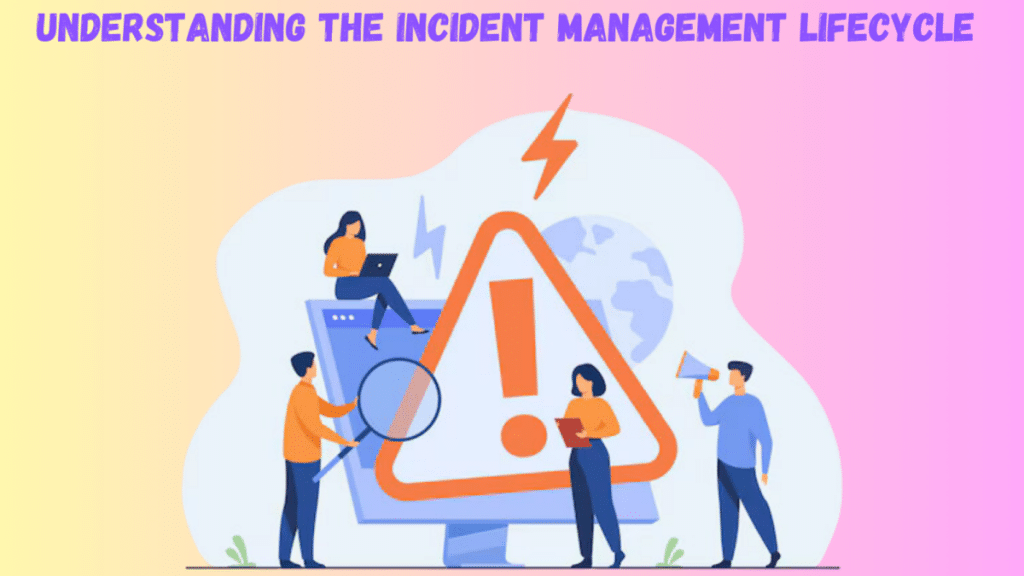Unexpected events in the fast-paced IT industry could seem like sudden automobile breakdowns. ITIL(Information Technology Infrastructure Library) comes in handy here because it offers a methodical way to handle these blunders. ITIL Incident Management is one of its main parts; it responds quickly to events to bring regular operations back. Any company depending on IT systems must understand the incident management lifecycle. Let’s explore this interesting method and observe how it maintains everything operating well, thereby guaranteeing that, should IT problems develop, they are quickly and effectively fixed.
Stage 1: Incident Identification
Realising any problem exists is the first step towards addressing it. This is incident identification in IT terms. Events can be reported via automated monitoring tools, system alarms, or user complaints, among other outlets. The secret is to spot the issue fast and precisely. See it like noticing the smoke before it becomes a full-fledged fire. Early identification will help avoid many problems down the road.
Stage 2: Incident Logging
Once an incident is found, it must be reported. This is not only a routine clerical chore; it’s also essential for managing the incident throughout its lifetime. Recording specifics, including the time of occurrence, impacted systems, incident type, and any first observations, is known as logging. This stage guarantees that nothing falls between the lines and offers a historical record that would be rather helpful for the next development and study.
Stage 3: Incident Categorisation and Prioritisation
Not every incidence is generated equally. While some are little mistakes, others can cause disastrous breakdowns. Categorising an event means putting it into a category based on set criteria, like how important it is or how quickly it needs to be dealt with. This helps in prioritising the incidents. Priority is the process of deciding which occurrence should be given top attention. First addressed are high-priority events impacting critical systems or many users. It’s like triaging patients in an ER; the most critical cases receive quick attention.
Stage 4: Incident Diagnosis
The detective work now begins. Investigating the underlying cause of an issue is known as incident diagnosis. Using their knowledge coupled with diagnostic tools and methods, IT staff help identify the problem’s cause. This stage is vital since treating the symptoms without addressing the underlying cause can result in reoccurring issues. It’s like mopping the water and then fixing the leak in a pipe.
Stage 5: Incident Escalation (If Necessary)
At times, the first responders might not have the tools or knowledge to handle an event. Under such circumstances, the event is escalated to either specialised staff or higher-level support teams. Escalation guarantees that the correct people with the correct tools are addressing the issue. It’s like calling in a specialist when your primary practitioner cannot identify the cause.
Stage 6: Incident Resolution
This is the moment everyone has been waiting for—incident resolution. Resolution is the remedy or workaround used to restore regular service. It might be a hardware replacement, a configuration modification, or even a software update. As fast as feasible, things should be back to normal. It’s the IT version of a mechanic getting you back on the road after fixing your automobile.
Stage 7: Incident Closure
Once the problem has been fixed, it’s time to close the case. Incident closure confirms that regular operations have started once the resolution has proved successful. It also entails adding any lessons gained and the resolution specifics to the incident journal. This phase guarantees that the incident does not resurface nasty head-on and facilitates the development of the next incident handling strategy.
Stage 8: Incident Review and Continuous Improvement
The last level is essentially for introspection and education. Analysing the incident helps one grasp what went wrong, what was done properly, and how similar events might be avoided going forward. An incident review, sometimes referred to as a post-mortem, is a process of ongoing development that helps to hone incident control strategies. Consider it a debrief following a mission: knowledge of the achievements and mistakes will help you be more ready the next time.
Why It Matters
Any company depending on IT systems—which, let’s face it, is practically every company nowadays—must first understand the incident management lifecycle. Good incident management guarantees quick reaction to problems, reduces downtime, and raises general service quality. It’s like having a well-oiled pit crew maintaining the seamless performance of your vehicle on the corporate racecourse.
To sum up, incidents are an unavoidable aspect of IT running. But companies can effectively handle these events and maintain their systems running like a dream with a strong Incident Management Lifecycle in place. That means you’ll know there’s a superhero squad ready to swoop in and save the day the next time your IT system acts out of control.
Understand ITIL easily with The Knowledge Academy courses.


